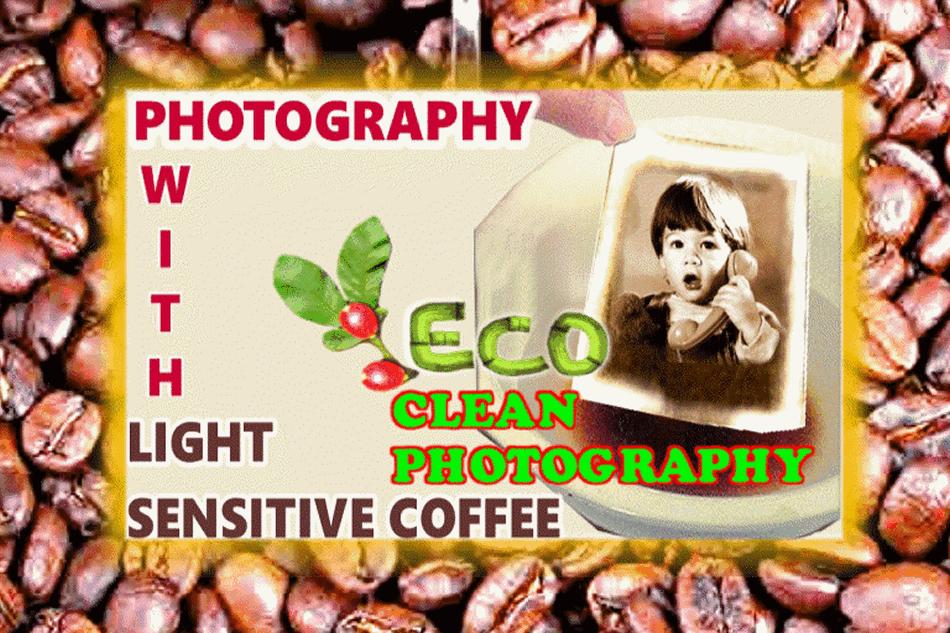
2024
LIGHT SENSITIVE COFFEE
CLEAN PHOTOGRAPHY
after 11 years research,
i managed to make coffee sensitive to light.
A fadeless print made directly on this photographic coffee paper will last for centuries and can be
developed and fixed in plain water in less
than 2 minutes.
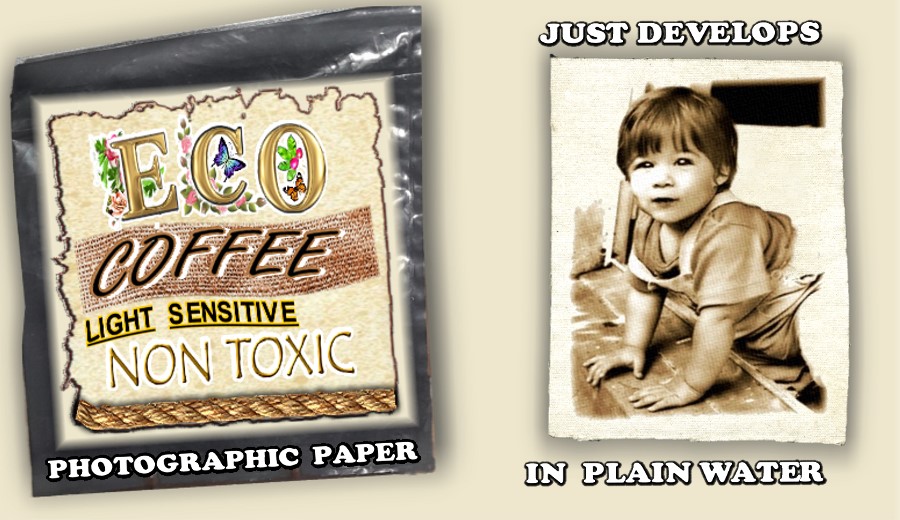
It is absolutely non toxic,
the fingers only touch water and coffee.
GREEN PHOTOGRAPHY

It is so easy and simple to work
that EVEN CHILDREN without a darkroom
can work it.
In tune with the ecological spirit of
Costa Rica, I have called it: "ECO-PAPER"
CLEAN PHOTOGRAPHY

V I D E O S
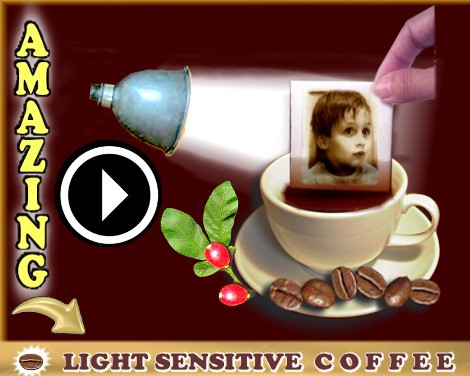
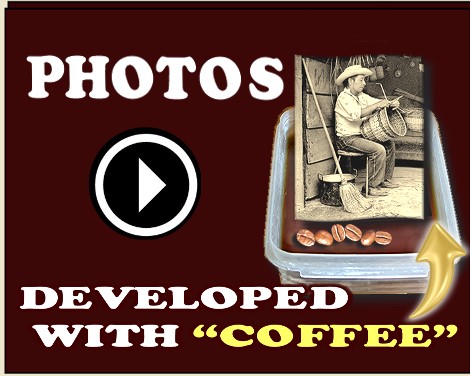
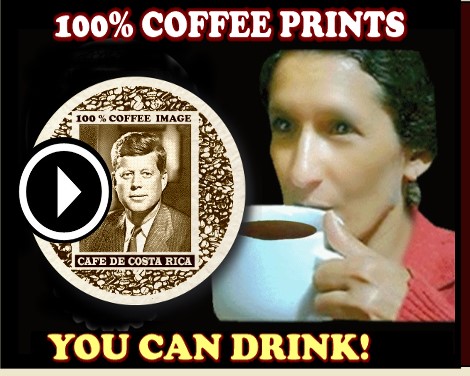
"SILVER EMULSIONS"
& "NON TOXIC "LIGHT SENSITIVE COFFEE"
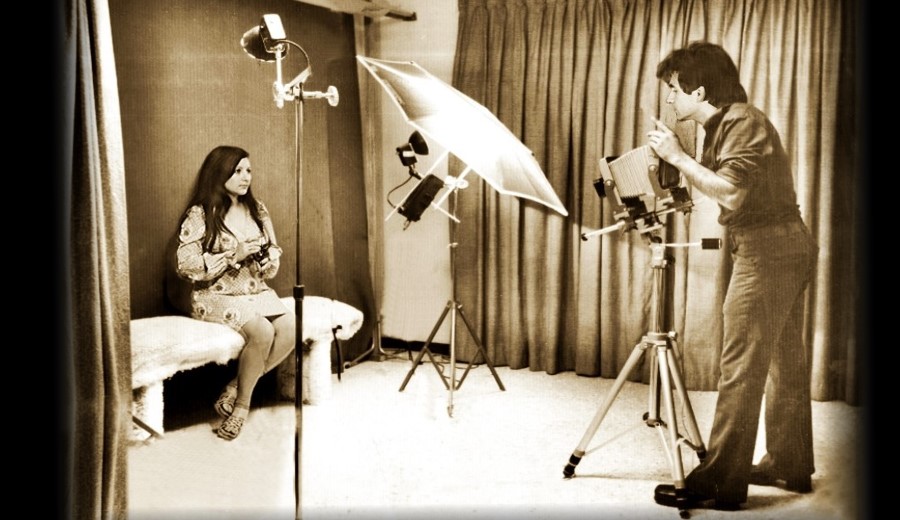
1975
I started a career in photography and
My research in PHOTOCHEMISTRY more than 40 years ago.
During those years I worked out many new ways and processes using
coffee liquid and in dry form.
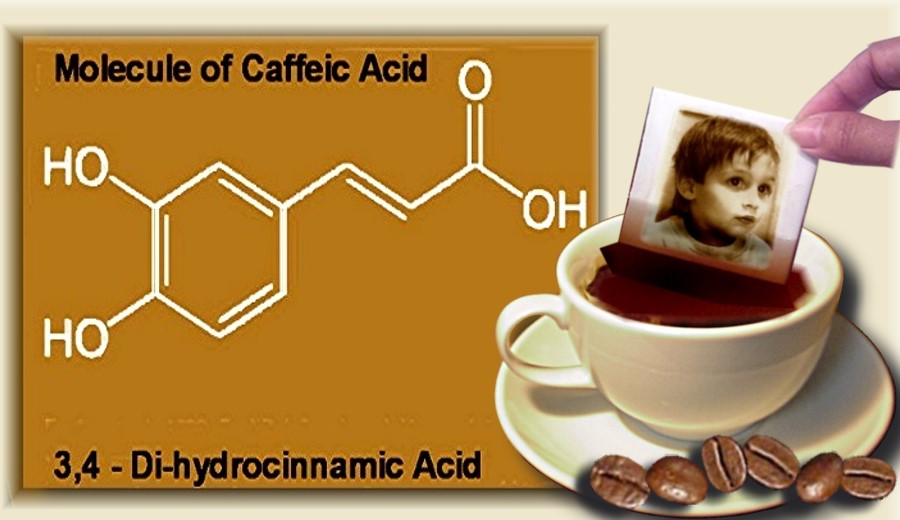
1989
I discovered in coffee as developing agent. My Research lab was
surrounded by coffee fields. This was filmed and shown in in the main
Television channels of Costa Rica. I found that the extracts of the leaves
of the coffee plants and not roasted coffee seeds were a more potent
reducing agent than the beverage of roasted beans.
In all of them the principal reducing agent was:
3,4-Di-Hydrocinnamic Acid , which I isolated and crystallized.
I also found the this reducing acid is a tanning agent in the
presence of gelatin.

1992
two of these methods were documented live and seen
by more than 100 million people in latin america and the USA.
filmed in Sabados Gigantes/ Don Francisco.
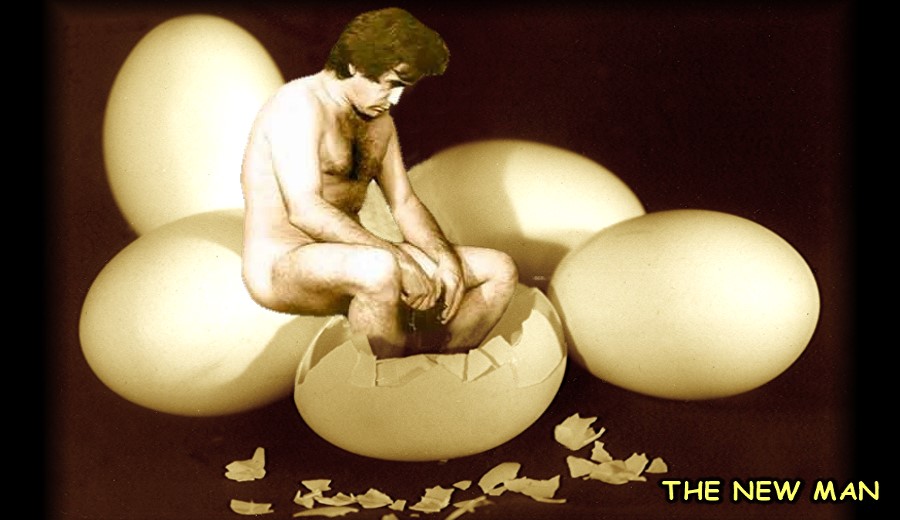
1993
some of my coffee Art works won medals and awards
in the USA international northwest exhibition of photography.
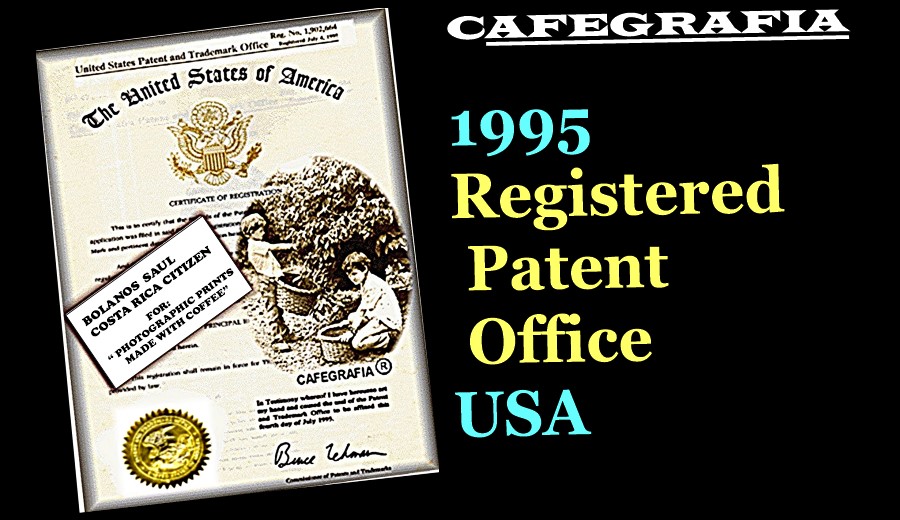
1995
I disclosed in the US patent office a new way of making edible
and drinkable images using 100% coffee as a coloring matter.
there in the same year I also registered "CAFEGRAFIA" as trademark
for making photographic images with coffee in several different ways.
1995
My last major exhibit was in in the the Art gallery of congress of Costa Rica
where 30x40 inch large format coffee prints were exhibited.
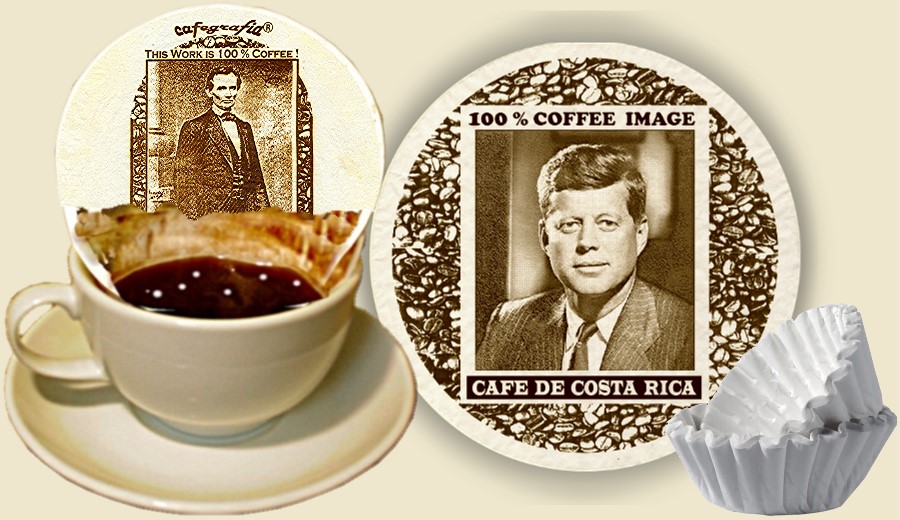
1996
I invented a printing process that yielded 100% coffee
photographic images in chemically pure filter paper that could be drank.

1999
I made a photographic silver chloride paper that after being
developed with coffee; its image could be TRANSFERRED to any support ,
metal, glass, wood, stones, etc This paper could be FIXED IN PURE WATER
instead of the traditional hypo o thiosulphate fixer.
Thus this paper was ecological, it did away with the irritating
developer agents used at the time. I also found that slaked lime was
the ideal activating agent than the usual alkali sodium carbonate, It yields
high contrast and very clean image and is not caustic on the skin when
neutralized by the caffeic acid.
I also found out in that year that silver chloride emulsion could be
fixed with kitchen salt instead of the hypo fixer, and also that coffee was an excellent toning agent. all of this and many other of my discoveries were new.
My ECOLOGICAL WORK continued 20 more years.
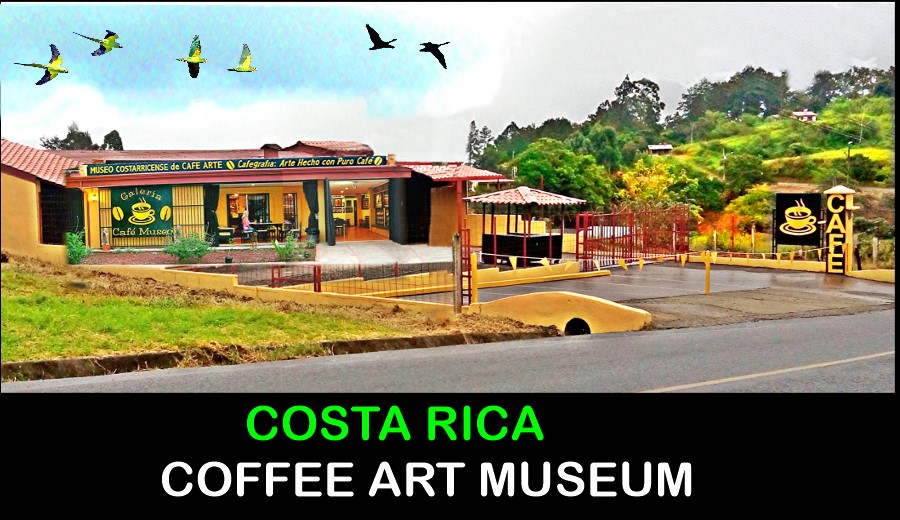
2010
I built in the first coffee art museum
exhibiting more than 500 of my artworks.
there I imparted, for 5 years workshops for students and artists.
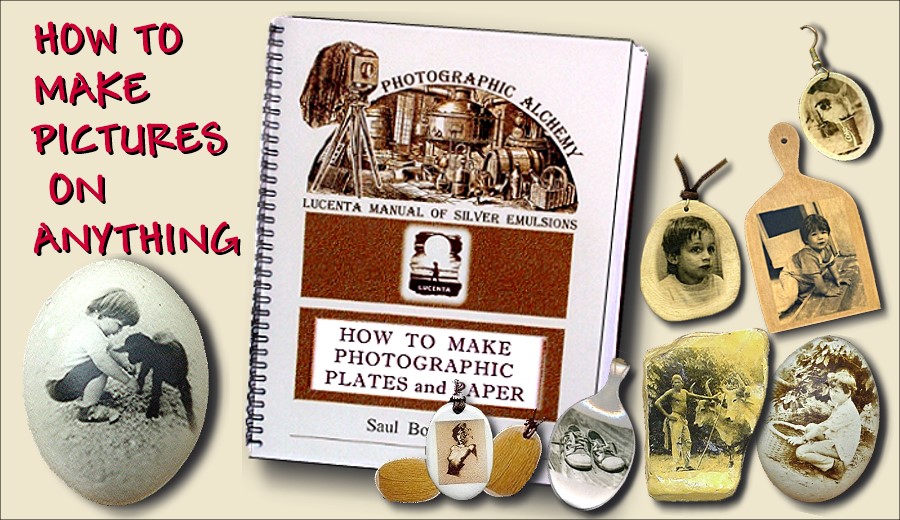
2005
I wrote of book of silver gelatin emulsions
HOW TO MAKE PHOTOGRAPHIC PLATES AND PAPER.
with more than 300 illustrations of my authorship, in it, formulas
of My Panchromatic and Orthochromatic ultra rapid negative emulsions
were given yielding ISO 32 can be pushed to ISO 64.
CHAPTERS 1 to 14
I N D E X
BOOK: "SILVER PHOTO EMULSION
BOOK: make photo paper Silver Photo Emulsion
Positive & Negative. FORMULAS TO MAKE PICTURES ON ANY MATERIAL.
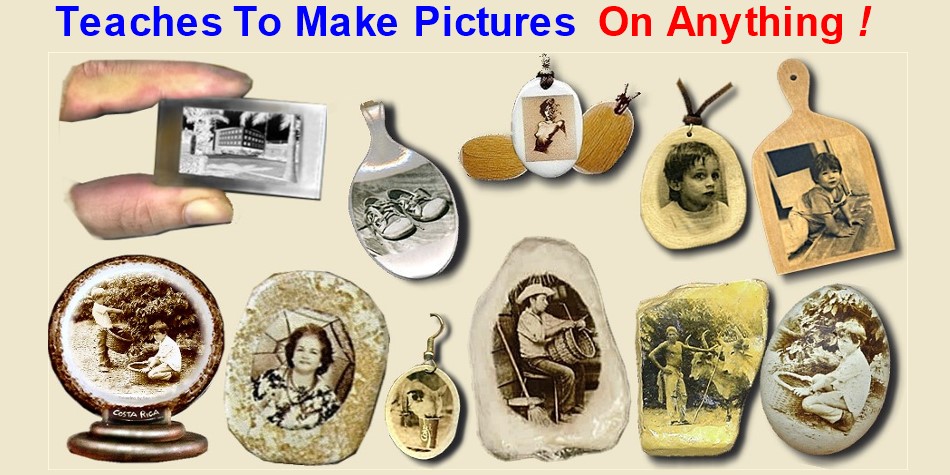
CONTENT, OPEN CHAPTERS:

 CHAPTER 1
CHAPTER 1
Emulsion Speed History, Wet Collodion 1855-1880,
Gelatine Pioneers Harrison 1868, Maddox 1871, King and Johnston 1873, Johnston, Burgess, Bolton. Bennet 1878 Introduces First Ripening. Mansfield 1879 Improves Ripening, Commercial Silver Bromide Plates 1878, Sensitivity of Wet Collodion Plates, Eder Introduces Ammonia Emulsions, Rapid Ammonia Plates 1880 ASA 3 ASA 6 to ASA 20,
1890-1915 Dye Sensitization, I873 Orthochromatic Plates 1882, Erythrosine 1884, Panchromatic plates 1902, Super color sensitizing dyes 1926 Orthochrome, Pinacyanol, Pinaverdol Sheppard Sulphur Sensitization, Cramer’s Precipitation Techniquel927, Antifog agents, ASA 125 by 1935 Kolowsky Gold Sensitization 1936, Techniques combined ASA 320 1945, Color reversal Film ASA 25, 1945 - 1980, Ultra Speed Color and Monochrome Highest color films speed ASA 160, 1975 Exposure Table for ASA O.25 to ASA 250.
 CHAPTER 2
CHAPTER 2
Gelatine Photo Grade, Gelatin Sulphur Oxidation,
Liming bone gelatin PH of gelatine and emulsions Hard soft and medium, hard gelatine, gelatine quantity in proportion to silver Hardener for gelatin, Chrome Alum, Formol, Potassium Alum, Gelatine Sensitizers, Active medium active Inert gelatines. Sulphur, Retarders and Antifogants , Inert Gelatines, To make gelatin inert / citric acid, Practical Sulphur Sensitization, How to Sulphur Sensitize and test GELATINE, TABLE / Gelatin Types.
 CHAPTER 3
CHAPTER 3
Elemental Emulsion Chemistry
Emulsion how it is formed, Excess of Soluble Halide, Potassium Bromide, Ammonium Bromide, Halogen equivalent Table Chemical Hazards / Ammonia, Silver Nitrate, Chrome Alum, Salicylic Acid, Tools & Chemical in Emulsion Making, Basic steps in Emulsion Manufacture.
 CHAPTER 4
CHAPTER 4
Emulsion Washing,
Why Emulsions are Washed, -Soluble ingredients: Ammonia, Potassium Nitrate, Ammonium or Potassium Bromide. Insoluble ingredients: Gelatine, Silver Bromide or Silver Iodide -Washing Emulsion Figure 1, -Washing in 7 basic illustrated steps, -Emulsion Washing table 1 for ammoniacal and neutral emulsions.
 CHAPTER 5
CHAPTER 5
Ammonia # 1 Emulsion For Testing Gelatin,
Positive ammonia emulsion formula, -How to re-dissolve Silver Nitrate with Ammonia. - Precipitation under Red Light, -Graphic Step by Step Summary, -Emulsion Mixing, illustrated -Preparing the salts solution, -Precipitation, -Emulsion Washing illustrated in 9 steps, -Re-melting washed emulsion, - Second Ripening. / Testing by dividing it in Separate Lots. -Second Ripening with “normal” type of gelatine. -with overactive, fogging gelatin type x. -Second Ripening with “Inert” type of Gelatines. -Ortho-Chromatization with Erythrosine. -How to get more speed with # 1 Emulsion. Keeping uncoated emulsion in refrigerator. Coating Finished Emulsion number 3, -Shelf Life of Coated Material
 CHAPTER 6
CHAPTER 6
Hand Coating Plates & Paper
Coating 35 mm Glass Plates,-Preparing a coating Table, -Drying Glass Plates, -How to Pack the Plates, -Exposing the Plates, -Exposure table for ASA 3 Sensitivity, -Processing the Negative, -Paper Developer D 72 Formula, -Fine grain boric acid film developer, -Printing the Negative by Enlarging, -Enlarging exposures for emulsion #1, -How to Coat Paper with a brush and how to dry it with warm or cold air.
 CHAPTER 7
CHAPTER 7
Chlorobromide Emulsion,
Unwashed Positive Emulsions Chloride and Chloro-bromide Emulsions, general principles, -Developing Times, / Warm Tones, -Variable Contrast, -Enlarging Speed /Chloride emulsion # 2, -Combining Molecular Weights of Sodium Chloride with Silver Nitrate,
Chloro-bromide Unwashed Positive Emulsions,-Rapid Positive emulsion # 2 Formula, -Text Instructions -Illustrated step by step instructions, -Contrast / Speed / Stability - Tones: Black to Sepia, -D 72 Paper developer formula ,-Processing/ develop/ fix / wash, -Emulsion Capacity, -Extra Rapid Emulsion # 3 formula.
 CHAPTER 8
CHAPTER 8
Chloride Unwashed
Positive Emulsions
Contact Speed Emulsion # 4, -step by step how to make it, -processing Chloride Emulsion # 4, - boric Alum Hardening St0p Bath Formula, -Contact Speed, / how to Contact Print -Coating Paper, / Drying Paper, -Emulsion Capacity, -sensitivity to white light, -Contact Printing, / Make exposure -developing for blue black tones, -processing, develop, fix/ wash, - exposing developing for warm tones, -extra warm hydroquinone developer, -Ortho-Chromatization with Erythrosine of Chloride & Chloro-Bromide emulsions, -Washing Emulsion (optional), -LUCENTA Chloride # 5 Extra Slow Positive Emulsion formula, -Compared Light Sensitivity of 3 different Positive Chloride emulsions, extra Rapid Chloride Positive Emulsion # 6, -Covering Power, Emulsion Capacity.
 CHAPTER 9
CHAPTER 9
Rapid Negative Emulsion
-Antihalo fine grain,/Analysis of Formula, -Role of: Potassium Iodide, excess of halide / Concentration of precipitants, Concentration of Gelatine,/ Agitation during mixing, / Rate of addition of Silver, /precipitation time,/ nucleating With 20% of Silver in Advance, / Mixing Temperature, Making different quantities of Emulsions, - Ratio AG / Gel, -Washing excess of free bromide, -Second Ripening Temperature, -Gel concentration during second ripening, -Volume after washing, - Rapid Negative Emulsion# 7 Formula, - Spectral or color Sensitization by bathing, / preparing Erythrosine baths, - use of Nitrobenzimidazole as stabilizer instead of Potassium Bromide, -Panchromatization, Dyes added directly to emulsions: Pinacyanol, Pinaverdol -Panchromatization by bathing, formulas, -how to process glass plates Without damage, -Gold Sensitization preparing Gold thiocyanate sol, Dosages, Testing.
 CHAPTER 10
CHAPTER 10
Emulsion Problems & Solutions,
-Age Fog, -Testing liquid emulsion when chilled, -Melting Points of Gelatin, -Testing for Biodegradation, -Test for chemical Fog, - coating / drying/ -Testing for frilling, -processing baths and sequence, -Developing times for different types of emulsions, Chloride, Chloro- Bromide,/ Bromo-Iodide. -emulsion improver compositions, -Antifrilling composition # 1,/ potassium alum added to Emulsion, -Antifrill comp. # 2, hardener, Chrome Alum, -Chrome Alum -Effects of over hardening, -Mild Antifogant —Potassium Bromide, antifog dosage, -Nitrobenzimidazole/ as fog clearer dosage in emulsion, / dosage to developer bath, Molecular composition, Hypersensibilization of Emulsion with Sodium Sulphite, / With Sodium Carbonate, -List of Emulsion & Processing Faults, blisters, stains, frilling, / softening, -Emulsion Coating Faults,/ uneven pools of emulsions, / Over working the fixing Bath. -Conditions affecting speed and Contrast. —Speed changes, contrast, maximum blacks./ -COATING WEIGHT OF EMULSION ON GLASS.
 CHAPTER 11
CHAPTER 11
Formulary, Subs, Toners, picture varnishes
baths/ etc, -Preparing different materials prior to coating with emulsion. -Clear Sub # 1 for wood, / porous. -Sub # 2 for glass glazed Ceramics, -Sub # 3 for glass,/metal,/ special applications, -sub # 4 Heavy Duty for glass & glazed Ceramics. -Sub # 5. White Primer for filling porous materials and impart white ground. -Sub # 6 For adherence of emulsion to acrylic or oil primed commercial artist Canvas. -How to coat Bare Metal with emulsion. -Clear Varnishes or Opaque Paints as subs or colored grounds. -Polyurethane Varnishes. - Coating Plastic Materials. -IMAGE PROTECTION / clear Acrylic varnishes, -Boric Acid, pot alum, Acetic Acid in Fixing Bath, - F5 Hardening thiosulphate Fixing bath formula, -Capacity of fixer for hand coated materials ,- Processing Hand coated emulsions, -How to Prepare Sodium Thiosulphate. -LUCENTA Direct Sepia T0ners,/ Hot Toner 406, / Cold Toner 407, with Thiosulphate and Tartaric Acid. Hot Toner 220. use of commercial fixing baths, -ANTISEPTICS & FUNGICIDES. to prevent mould on Liquid uncoated emulsion. / Ethyl Alcohol, Salicylic Acid, Nitrates as Antiseptics in Unwashed Emulsions.
 CHAPTER 12
CHAPTER 12
Pinhole Photography Camera without a Lens.
-Simple Pinhole Camera. -Outdoor exposure table for ASA 8 Without a Light Meter. -Perspective by hole to plate distance. -Pinhole Camera for Copying /macro work 1:1 Magnification. -How to Make the perfect Hole .-Diameter of standard needles. -Diameter of hole on image quality. -how to measure pinholes. -Focal Values of Pinholes. -pinhole with a 35 mm Reflex camera. -Calculate exposure by using alight meter. materials and plastics sanded with steel. -Photography without a lens and coating your own plates.
 CHAPTER 13
CHAPTER 13
how to make digital negatives
in your computer for alternative photography process like
for liquid light sensitive silver gelatine emulsion.
 CHAPTER 14
CHAPTER 14
how to develope pictures with coffee.
the author discovered in costa rica around 1989, coffee as reducing agent for silver salts. He worked out a COMPLETELY NON TOXIC DEVELOPER and also engineered a silver chloride emulsion which can be developed with coffee and BE FIXED WITH PLAIN WATER ! This is the most ecological silver process ever devised in the history of photography.
TEXT MESSAGESIN
COSTA RICA
(506) 6012 4695
CONTACT
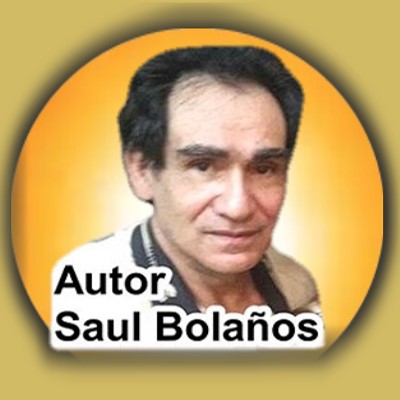
CAFEDESAUL@GMAIL.COM